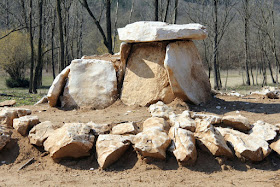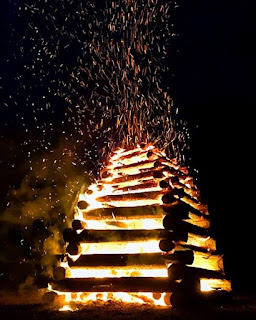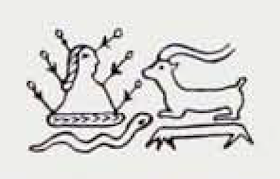This is the 7th c. AD depiction of the moment when the Devi (goddess) Durga riding on a lion slays Asura (demon) Mahisha whose name means buffalo...
From Mahishasuramardini Mandapa, Mamallapuram, Tamil Nadu, India
In the perpetual conflict between Devas and Asuras, in the battle between the gods and the demons, the Devas led by Indra (riding on an elephant) were defeated by Mahisha, the Buffalo demon...
Dejected by their defeat, the Devas assemble in the mountains where their combined divine energies coalesce into goddess Durga...
The newborn Durga, riding on a lion, led a battle against Mahisha, buffalo demon, and killed him. Thereafter she is named Mahishasuramardini, meaning "the killer of Mahishasura"...
Sooooo... What does all this mean?
To understand this story we need to look at the animal symbolism found in it. Namely Buffalo (bad) and Elephant and Lion (good) 🙂...And the local climate...Yup, again...
Just like in all other Eurasian and North African cultures, animals in legends are solar year calendar markers, developed from a well known annual events in the lifecycle of the animals in question, which happen every year at the same time...You can find the links to all the articles about these solar year calendar markers on this page in my blog.
When it comes to animals that usually means either beginning of the mating season or less commonly beginning of the birthing season...
In Durga-Mahisha story, buffalo, elephant and lion are solar calendar markers developed from the times of the mating seasons of these animals...
In "Vanishing Herds of Wild Water Buffalo" we can read that "Buffalos, more precisely Wild Water Buffalos are seasonal breeders in most of their range, typically in October and November"
Similar seasonality is observed with domestic buffalos. In "Buffalo breeds and management systems" we can read that "...In Rajasthan, the breeding season started in the rainy period and the winter appeared the most favourable season while the summer appeared the most unfavourable season for buffalo reproduction...for buffaloes breeds in Pakistan...the breeding frequency was highest during the winter, decreased in autumn and spring, and was lowest in the summer...The same is true for Italy..."
Asian Elephants are also seasonal breeders, mating between June and September, with peak in July and August...
July-August is the part of the year marked by Leo...Now Eurasian Lions are also seasonal breathers. In the "THE ASIATIC LION: A study of ecology and behaviour" by Paul Joslin we can read that the mating season of the Asiatic lions starts in August and lasts until October.
This is based on the field research which was done between 1968-1971 in the Gir Forest Sanctuary in India...
If we look at the climate in India, we can see that the year is divided into two parts: wet part (Jun-September) and dry part (October-May).
The monsoon, wet season coincides with the elephant mating season...Which is why Indra, the rain god, rides on an elephant...
I talked about this link between monsoon, elephant mating season and Indra in detail in my post "Musth"...
The monsoon, wet season ends in September. And long dry season begins...In October, right when water buffalo mating season starts...
So water buffalo mating season starts when elephant mating season ends...Mahisha, buffalo, dry season "defeats" (succeeds) Indra, elephant, wet monsoon season...And this happens every year which is why this is a "perpetual conflict"...
Anyway, Mahisha beats Indra, rains stop...The weather stays dry all winter...Then in spring and early summer droughts start...
But just when people (and Devas, Gods) start to despair, Himalayas start to heat up in the early summer (April-May). And the updraft this creates starts sucking the moist Indian ocean air across India towards the mountains...
The monsoon starts...The Devas, assembled in the mountains have created Durga, the Invincible one, the defeater of Mahisha...
But Mahisha is not an easy "demon" to kill...Durga fights him for a long time, until finally, she kills him while "riding on a lion"...
Now Durga is not the only "warrior" goddess that rides on a lion...There's one for everyone in the audience 🙂
"The Lady" Durga arriving on a lion could mean "in Leo" July-August, or it could be "after Leo" which is Virgo, August-September...
So is Mahisha actually finally defeated by Durga in August, in Leo, at the peak of the monsoon season, or in September, in Virgo, at the end of the monsoon season???
Regardless which point in time exactly we take to be the moment of Durga's victory over Mahisha, this victory of Devas over Asuras is short lived...
Because after September comes October. The dry season starts. Right at the start of the Water Buffalo mating season. Mahisha again defeats Indra...Only to be in turn defeated by Durga...And so perpetual struggle between "good" (Devas, rain) and evil (Asuras, drought) continues...
Again, this time in India, we find animal solar year markers used originally to mark significant event in the local solar year (agricultural) calendar. In this case succession of monsoon season and dry season...Only to later become obscured and mythologised...
















































